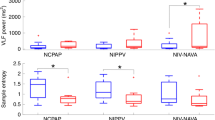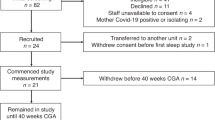Abstract
Background
To examine the correlation between interval vital signs recorded by nursing staff and continuous monitor recordings, and to determine whether aggregated monitor recordings can better predict impending escalation of respiratory support in premature infants.
Method
Preterm infants on noninvasive respiratory support or room air (RA) were prospectively enrolled. Nursing-and monitor-recorded pulse oximetry (SpO2) and respiratory rates (RR) data were recorded daily.
Results
Ninety four infants were recruited with median gestational age of 32 weeks and birth weight of 1848 g. > 3 × 106 data points were analyzed over 2204 patient days. Median events/day recorded was 8 (nursing) and 1424 (monitor) per infant. We did not find a strong correlation between monitor- and nursing events of tachypnea (RR > 70) and hypoxia (SpO2 < 90%). Infants with monitor-recorded hypoxia for > 5%/day (p < 0.0001) or tachypnea for > 30%/day (p < 0.0001) were more likely to require an increase in respiratory support within next 3 days. Monitor-recorded hypoxia and tachypnea were also associated with poor weight gain.
Conclusions
Monitor-recorded trends for tachypnea and oxygen saturations < 90% were able to predict short-term respiratory outcomes, and were associated with growth outcomes. This study emphasizes the potential for monitor-recorded data to augment clinical decision making at the bedside.
Similar content being viewed by others
Log in or create a free account to read this content
Gain free access to this article, as well as selected content from this journal and more on nature.com
or
References
Amatya, S., Macomber, M., Bhutada, A., Rastogi, D. & Rastogi, S. Sudden versus gradual pressure wean from Nasal CPAP in preterm infants: a randomized controlled trial. J. Perinatol. 37, 662–667 (2017).
Yang, C., Yang, M., Chu, S., Chiang, M. & Lien, R. A randomized pilot study comparing the role of PEEP, O2 flow, and high-flow air for weaning of ventilatory support in very low birth weight infants. Pediatr. Neonatol 59, 198–204 (2018).
Walsh, M. et al. Oxygen delivery through nasal cannulae to preterm infants: can practice be improved? Pediatrics 116, 857–861 (2005).
Kraaijenga, J. V., de Waal, C. G., Hutten, G. J., de Jongh, F. H. & van Kaam, A. H. Diaphragmatic activity during weaning from respiratory support in preterm infants. Arch. Dis. Child. Fetal Neonatal Ed. 102, F311 (2017).
Carlo, W. A. et al. SUPPORT Study Group of the Eunice Kennedy Shriver NICHD Neonatal Research Network Target ranges of oxygen saturation in extremely preterm infants. N Engl J Med 362, 1959–1969 (2010).
Askie, L. M., Henderson-Smart, D. J., Irwig, L. & Simpson, J. M. Oxygen-saturation targets and outcomes in extremely preterm infants. New Engl. J. Med. 349, 959–967 (2003).
Schmidt, B. et al. Effects of targeting higher vs lower arterial oxygen saturations on death or disability in extremely preterm infants: a randomized clinical trial. JAMA 309, 2111–2120 (2013).
Lighthall, G. K., Markar, S. & Hsiung, R. Abnormal vital signs are associated with an increased risk for critical events in US veteran inpatients. Resuscitation 80, 1264–1269 (2009).
Bohanon, F. J. et al. Heart rate variability analysis is more sensitive at identifying neonatal sepsis than conventional vital signs. Am. J. Surg. 210, 661–667 (2015).
Claire, M. et al. The effect of the quality of vital sign recording on clinical decision making in a regional acute care trauma ward. Chin. J. Traumatol. 20, 283–287 (2017).
Taenzer, A. H., Pyke, J. B., McGrath, S. P. & Blike, G. T. Impact of pulse oximetry surveillance on rescue events and intensive care unit transfers: a before-and-after concurrence study. Anesthesiology 112, 282–287 (2010).
Brown, H. et al. Continuous monitoring in an inpatient medical-surgical unit: a controlled clinical trial. Am. J. Med. 127, 226–232 (2014).
Bravi, A., Green, G., Longtin, A. & Seely, A. J. E. Monitoring and identification of sepsis development through a composite measure of heart rate variability. PLoS ONE 7, e45666 (2012).
Gatewood, M. O., Wemple, M., Greco, S., Kritek, P. A. & Durvasula, R. A quality improvement project to improve early sepsis care in the emergency department. BMJ Qual. Saf. 24, 787–795 (2015).
Mithal, L. B., Yogev, R., Palac, H., Gur, I. & Mestan, K. K. Computerized vital signs analysis and late onset infections in extremely low gestational age infants. J. Perinat. Med. 44, 491–497 (2016).
Moorman, J. R. et al. Mortality reduction by heart rate characteristic monitoring in very low birth weight neonates: a randomized trial. J. Pediatr. 159, 906.e1 (2011).
Fairchild, K. D. et al. Septicemia mortality reduction in neonates in a heart rate characteristics monitoring trial. Pediatr. Res. 74, 570–575 (2013).
Mithal, L. B. et al. Vital signs analysis algorithm detects inflammatory response in premature infants with late onset sepsis and necrotizing enterocolitis. Early Human. Dev. 117, 83–89 (2018).
Poets, C. F. & Southall, D. P. Patterns of oxygenation during periodic breathing in preterm infants. Early Human. Dev. 26, 1–12 (1991).
Wellington, G., Elder, D. & Campbell, A. 24‐hour oxygen saturation recordings in preterm infants: editing artefact. Acta Paediatr. 107, 1362–1369 (2018).
Holden, M. S. et al. Urinary hypoxanthine as a measure of increased ATP utilization in late preterm infants. Infant, Child Adolesc. Nutr. 6, 240–249 (2014).
Groothuis, J. R. & Rosenberg, A. A. Home oxygen promotes weight gain in infants with bronchopulmonary dysplasia. Am. J. Dis. Child. 141, 992–995 (1987).
Moyer-Mileur, L. J., Nielson, D. W., Pfeffer, K. D., Witte, M. K. & Chapman, D. L. Eliminating sleep-associated hypoxemia improves growth in infants with bronchopulmonary dysplasia. Pediatrics 98, 779 (1996).
Tan, J. B. C., Boskovic, D. S. & Angeles, D. M. The energy costs of prematurity and the neonatal intensive care unit (NICU) experience. Antioxidants 7, 37 (2018).
Zapata, J., Gómez, J. J., Araque Campo, R., Matiz Rubio, A. & Sola, A. A randomised controlled trial of an automated oxygen delivery algorithm for preterm neonates receiving supplemental oxygen without mechanical ventilation. Acta Paediatr. 103, 928–933 (2014).
Claure, N. & Bancalari, E. Automated closed loop control of inspired oxygen concentration. Respir. care 58, 151–161 (2013).
Alzoubi, K., Alguraan, Z. & Ramahi, O. Portable automated oxygen administration system for hypoxaemic patients. SpringerPlus 5, 1–18 (2016).
Author information
Authors and Affiliations
Contributions
N.K.: Substantial contributions to conception and design, acquisition of data, or analysis and interpretation of data; Drafting the article or revising it critically for important intellectual content; and Final approval of the version to be published. A.W.: Substantial contributions to acquisition and analysis of data. R.M.: Substantial contributions to analysis and interpretation of data. Revising the article critically for important intellectual content. V.S.: Substantial contributions in conception, drafting the article, and revising it critically for important intellectual content.
Corresponding author
Ethics declarations
Competing interests
The authors declare no competing interests.
Additional information
Publisher’s note: Springer Nature remains neutral with regard to jurisdictional claims in published maps and institutional affiliations.
Rights and permissions
About this article
Cite this article
Warburton, A., Monga, R., Sampath, V. et al. Continuous pulse oximetry and respiratory rate trends predict short-term respiratory and growth outcomes in premature infants. Pediatr Res 85, 494–501 (2019). https://doi.org/10.1038/s41390-018-0269-4
Received:
Revised:
Accepted:
Published:
Issue date:
DOI: https://doi.org/10.1038/s41390-018-0269-4
This article is cited by
-
Predicting the treatment-requiring retinopathy of prematurity using birth weight, laboratory data and continuous peripheral capillary oxygen saturation monitoring
Japanese Journal of Ophthalmology (2025)
-
Device for remote and realtime monitoring of neonatal vital signs in neonatal intensive care unit using internet of things: proof-of-concept study
Journal of Clinical Monitoring and Computing (2023)
-
Laser spectroscopic method for remote sensing of respiratory rate
Physical and Engineering Sciences in Medicine (2023)
-
Vital signs as physiomarkers of neonatal sepsis
Pediatric Research (2022)
-
Assessment of neonatal respiratory rate variability
Journal of Clinical Monitoring and Computing (2022)



